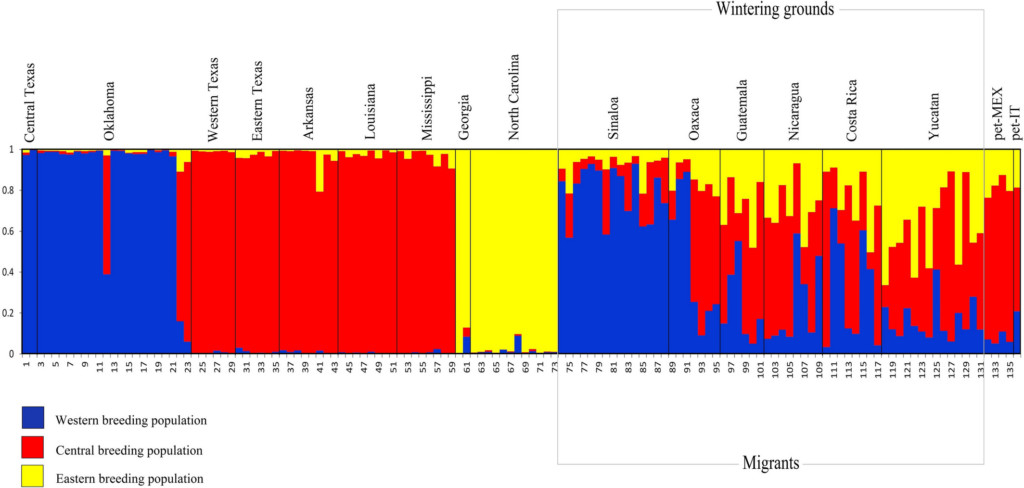LINKED PAPER
Genetic structure of the Painted Bunting and its implications for conservation of migratory populations. Contina, A., Alcantara, J. L., Bridge, E. S., Ross, J. D., Oakley, W. F., Kelly, J. F. & Ruegg, K. C. 2019. IBIS. DOI: 10.1111/ibi.12641. VIEW
The Painted Bunting (Passerina ciris) is a colourful songbird that breeds in North America. Over the last 30 years, several populations have drastically declined (Sauer et al. 2013). The reasons behind this decline are manifold, including habitat loss and fragmentation, predation by house cats, brood parasitism by the Brown-headed Cowbird (Molothrus ater) and illegal pet trade. To tackle these issues and take the right conservation measures, a group of ornithologists used molecular markers to gain a better understanding of the population structure of Painted Buntings.
Three populations
The researchers genetically characterized 131 individual birds with 13 microsatellites. A microsatellite is a string of repetitive DNA. The number of times a particular microsatellite is repeated can be used to infer the relationships between individuals and populations (Contina et al. 2016). The genetic analyses pointed to three distinct Painted Bunting populations from western, central and eastern United States. The western population corresponds to Oklahoma and central Texas, the central population runs from western Texas to Mississippi and the eastern populations includes two breeding sites along the Atlantic coast. These results are in line with previous work on the Painted Buntings (Herr et al. 2011, Battey et al. 2017).

Figure 1 Genetic population structure of the Painted Bunting. The colours correspond to three breeding populations: western (blue), central (red) and eastern (yellow). Some migrants could be assigned to particular breeding populations, but the multi-coloured profiles of some individuals indicate that birds are mixing at the wintering grounds.
Migrants
Birds sampled on the wintering grounds could be assigned to one of the three breeding populations. Migrants in Guatemala, Nicaragua, Costa Rica and the Yucatan Peninsula came from the central and eastern populations, whereas birds from Sinaloa and Oaxaca (western Mexico) originated from the western breeding population. However, the origin of several migrants remained uncertain, suggesting that birds from different breeding populations are mixing on the wintering grounds. The migratory routes uncovered by the molecular markers could inform conservation measures. For example, the Sinaloa wintering ground is mainly visited by the western breeding population and is thus a crucial location that should be prioritized in conservation efforts.
 Figure 2 The breeding grounds (yellow) and wintering areas (blue) of the Painted Bunting. The genetic analyses showed that some wintering areas, such as Sinaloa (Sin), require priority in conservation efforts.
Figure 2 The breeding grounds (yellow) and wintering areas (blue) of the Painted Bunting. The genetic analyses showed that some wintering areas, such as Sinaloa (Sin), require priority in conservation efforts.
Captive birds
The molecular markers might also be useful to trace the origins of illegally traded birds (Iyengar 2014). As a proof of concept, the researchers sequenced the DNA of several captive birds. They collected samples from Painted Buntings on a pet market in Mexico City and from a distributor of exotic birds in Italy. The analyses revealed that these birds could be traced back to the central breeding population. The authors conclude that their “low-cost molecular approach to assign pet market samples to natural populations is a valid method with great investigative potential in forensic genetic analyses of the Painted Bunting and other songbirds exploited in the international pet trade industry.”
References
Battey, C. J., Linck, E. B., Epperly, K. L., French, C., Slager, D. L., Sykes Jr, P. W., & Klicka, J. 2018. A migratory divide in the Painted Bunting (Passerina ciris). The American Naturalist, 191: 259-268. VIEW
Contina, A., Harrigan, R. J., Pollinger, J. P., Bridge, E. S., Kelly, J. F., & Smith, T. B. 2016. Genome-wide identification and characterization of simple sequence repeats in the Painted Bunting (Passerina ciris) for population and forensic analyses. Conservation Genetics Resources, 8: 43-81. VIEW
Herr, C., Sykes, P. & Klicka, J. 2011. Phylogeography of a vanishing North American songbird: the Painted Bunting (Passerina ciris). Conservation Genetics, 12: 1395-1410. VIEW
Iyengar, A. 2014. Forensic DNA analysis for animal protection and biodiversity conservation: a review. Journal for Nature Conservation, 22: 195-205. VIEW
Sauer, J. R., Hines, J. E., Fallon, J., Pardieck, K. L., Ziolkowski, D. J., & Link, W. A. 2013. The North American Breeding Bird Survey 1966-2011: Summary Analysis and Species Accounts. North American Fauna, 79:1-32. VIEW
Image credits
Featured image: Painted Bunting Passerina ciris | Doug Janson | CC BY-SA 3.0 Wikimedia Commons




